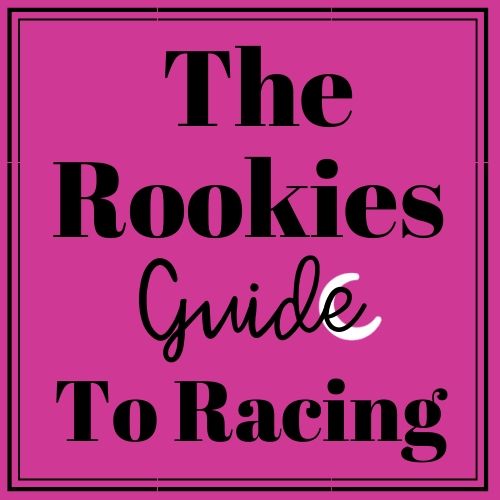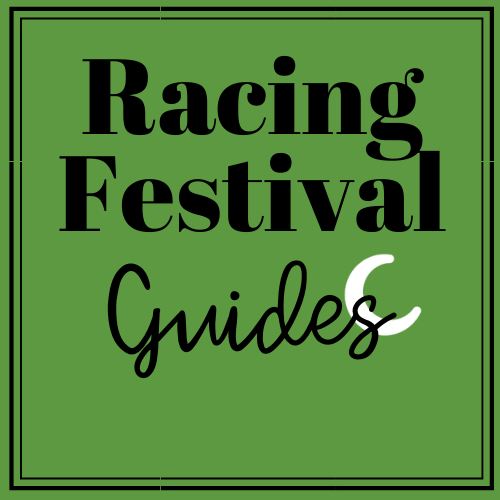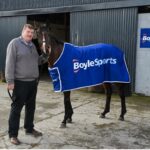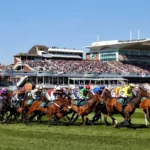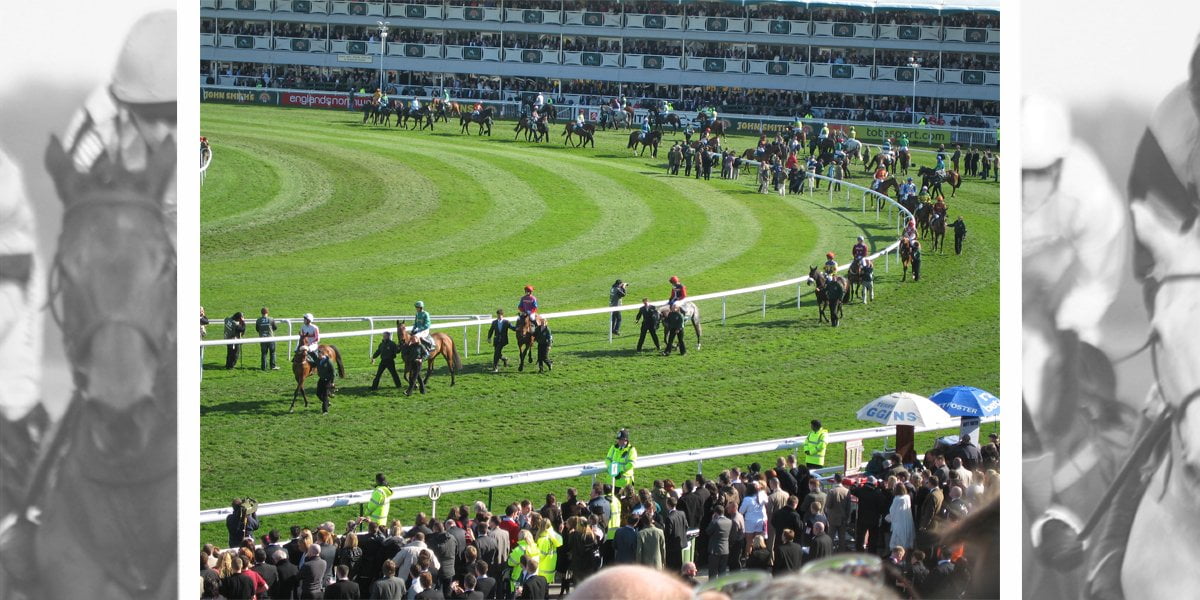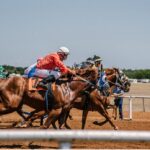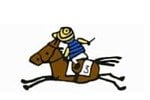Amberleigh House’s triumph in the 2004 Grand National provided Red Rum’s trainer Ginger McCain with a fourth success in the great race.
The victory of John Halewood’s horse saw him join Fred Rimell in the record books as the winning-most trainer in the Grand National’s long history.
Ginger McCain
The son of a dispatch manager, Donald McCain, or Ginger as he would universally become known due to the colour of his hair, was born on 21st September, 1930 in humble surroundings at Birkdale, Southport.
He watched his first National in 1940 and was immediately taken in by the sense of occasion that surrounded the famous race. “To a young boy, it seemed like the whole world had turned up … It made a big impression on me and ended up changing my life in ways I could never have dreamed of,” he recollected in his autobiography some 65 years later.
While dividing his time between driving a taxi and running a second-hand car showroom, Ginger also trained horses under a permit from 1953 until taking out a full licence in 1969. Among his fares was his future wife Beryl and they were married on 25th March, 1961, the same day that trainer Fred Rimell sent out the second of his four Grand National successes with Nicolaus Silver.
Ginger also had Frank Sinatra and Norman Wisdom in the back of his cab, but it was another passenger, Noel Le Mare, who would ignite the dream of winning the Grand National. Le Mare, who made his fortune in civil engineering, had been seduced by the magic of the race ever since he watched the spectacle unfold when working as an apprentice fitter for a Fleetwood, Lancashire firm in 1906, but it was not until he was nearly 80 that the retired millionaire found a trusted ally to share his long-held ambition.
The trainer and owner purchased Red Rum, born on 3rd May, 1965, for 6,000 guineas at Doncaster Sales in August, 1972, but any dreams of National glory looked to have gone awry as Red Rum hobbled out of his stable lame a day after arriving at Southport. Ginger’s preparation of a horse almost crippled by pedal osteitis marked him as a trainer of exceptional ability, if unconventional methods. With no grass gallops, McCain worked his horses on the vast expanse of Southport beach and, as a child, had noticed the beneficial effect of sea water on the horses that shrimpers used.
He sent his new acquisition into the cold waters of the Irish Sea and witnessed a remarkable transformation as the horse returned sound. Red Rum went on and won his first five races for Ginger.
The horse’s success under 10st 5lb in the 1973 Grand National at the age of eight became the stuff of legend as he wore down gallant top-weight Crisp (12st) in the dying strides for a remarkable victory by three quarters of a length in a then course record time under Brian Fletcher.
Red Rum was never better than in the 1973/74 season when he won four more races before collecting his second Grand National, this time carrying top-weight of 12st. Giving 1lb to the Cheltenham Gold Cup winner L’Escargot, Red Rum started third favourite at 11/1. He won easily by seven lengths when again partnered by Brian Fletcher.
Only three weeks later, Red Rum captured the Scottish Grand National.
Between the autumn of 1974 and spring of 1976, he ran in 18 chases, winning twice and being placed seven times including his second when Irish challenger L’Escargot turned the tables in the 1975 Grand National. Red Rum carried 12st again and was beaten 15 lengths.
Ginger, bombarded with media criticism for running Red Rum too often, was called on to retire his stable star. But Red Rum showed good form when sixth in the Hennessy Gold Cup at Newbury in November, 1975 and the following April, shouldering top-weight of 11st 10lb, was beaten by the Fred Rimell-trained Rag Trade in the 1976 Grand National, finishing runner-up, two lengths behind, after Tommy Stack took over from Fletcher in the saddle.
The 1976/77 season began dismally. After an initial small win at Carlisle, Red Rum appeared lacklustre in his next four races and even Ginger began to think that he might have ‘gone’. Red Rum finally showed something like his true form when sixth in his prep race to the 1977 Grand National, the Greenall Whitley Chase at Haydock. He then dazzled the trainer in his last gallop before Aintree.
Again ridden by Stack, Red Rum at the age of 12 tackled his fifth Grand National in 1977 and Churchtown Boy’s mistake at the second last fence settled things in the former’s favour, winning easily by 25 lengths under 11st 8lb.
Sir Peter O’Sullevan’s now legendary commentary for BBC Television was heard in millions of living rooms up and down the country as Red Rum took his place among the racing immortals: “The 12-year-old Red Rum, being preceded only by loose horses … they’re coming to the “elbow” with a furlong now between Red Rum and his third Grand National triumph. He’s coming up to the line to win it like a fresh horse in great style. It’s hats off and a tremendous reception – you’ve never heard one like it at Liverpool. Red Rum wins the National.”
The phenomenal chaser – the best Grand National horse ever – was trained for a sixth attempt at the great chase in 1978 as a 13-year-old but, on the day before, he pulled up lame. The problem proved to be a hairline fracture and the great horse had to be retired.
There was time for a glorious final chapter to Ginger’s training career as, 27 years after Red Rum’s final Grand National victory, the trainer walked back into the hallowed Aintree winner’s enclosure with Amberleigh House. The chaser was owned by Halewood International, whose founder and driving force John Halewood died in October, 2011. Halewood International, through its brand Crabbie’s, took over sponsorship of the Grand National for the 2014 renewal.
Ginger’s son Donald was by now an integral part of the family’s training establishment, having returned to the family fold after the move from Southport to Cholmondeley in Cheshire. The handover of the training licence from father to son occurred in June, 2006.
Donald, who had one Grand National ride when Sure Metal finished 17th in 1996, continued the McCain association with the Grand National as he saddled Ballabriggs to an emotional victory in the 2011 renewal, just five months before Ginger passed away peacefully at his home at the age of 80 on 19th September that year.
Ginger’s achievements and long association with Aintree were commemorated at the Grand National meeting in 2012 with the unveiling of a one-and-a-half time life-size bronze overlooking the parade ring. A life-size bronze of Red Rum, produced by former jockey Philip Blacker, has stood at Aintree Racecourse since 1988.
Fred Rimell
While Ginger forged a legend from nothing in the small yard behind his Southport car showroom, Fred Rimell inherited a Grand National-winning tradition from his father Tom, who sent out Forbra from the famous Kinnersley yard in Worcestershire to win the great race in 1932.
Regardless of his family heritage in racing, Rimell’s achievements were remarkable. He was a champion jump jockey four times – 1938/39, 1939/40, 1944/45 (jointly) and 1945/46 – but, as a rider, he endured wretched luck at Aintree. He missed out partnering on Forbra due to his inexperience and never rode a winner at the course. In five attempts in the Grand National, Rimell completed only once when Provocative finished a distant 12th behind Battleship in 1938.
His career in the saddle was cut short when he broke his neck for a second time in the space of eight months in 1947, after which he took over the training licence from his father. Rimell, born on 24th June, 1913, turned Kinnersley into one of the most powerful yards in England, winning four jump training titles and almost every big race in the calendar before his death in 1981, including the Cheltenham Gold Cup with Woodland Venture (1967) and Royal Frolic (1976), plus the Champion Hurdle with Comedy Of Errors (1973 and 1975).
At Aintree, Rimell reigned supreme, complementing his four Grand National triumphs with three victories in the Grand Sefton Chase, courtesy of Nicolaus Silver (1961), Red Thorn (1964) and his subsequent Scottish Grand National hero The Fossa (1965). E.S.B.’s 1956 Grand National victory under Dave Dick was memorable for the sensational collapse of Devon Loch 50 yards from the line, with the race all but won.
Devon Loch’s mishap under Dick Francis left E.S.B. to stride home 10 lengths clear of Gentle Moya. The 10-year- old was a fine horse in his own right and also gained the 1957 Great Yorkshire Chase and the Lancashire Chase two years later.
Rimell unearthed an Aintree specialist for the 1961 marathon in the handsome form of Nicolaus Silver, one of only three greys to have won the Grand National – the others being The Lamb, successful in both 1868 and 1871, and the 2012 victor Neptune Collonges.
Nicolaus Silver cost £2,600 at the 1960 Ballsbridge Sales in Ireland. He captured the big race the following spring by five lengths, with Bobby Beasley in the saddle, from Merryman II at 28/1. He went on to take the Grand Sefton under 11st 10lb and ran in the next two Grand Nationals, completing the course both times (seventh in 1962 and 10th in 1963).
Gay Trip was twice successful in the Mackeson Gold Cup (1969 and 1971) over an extended two and a half miles at Cheltenham, but proved a revelation over nearly two miles further around Aintree in 1970 when he triumphed by 20 lengths under 11st 5lb with 40-year-old Pat Taaffe up after his regular jockey Terry Biddlecombe was injured. He fell at the first in the 1971 Grand National and, giving 22lb to Well To Do, failed by only two lengths to overhaul that rival when runner-up in 1972.
Rimell was the first jump trainer to accrue prize money of £100,000 in a season in 1976 and Rag Trade’s success under John Burke that spring at 14/1 saw him achieve another record as the first trainer to win the Grand National four times.
Rag Trade, bred in Ireland, was trained by George Fairbairn when he arrived in Britain. He won the Haydock National Trial and would have taken the Kim Muir Chase at the 1975 Cheltenham Festival, only to fall at the last. He was sold shortly afterwards at Doncaster Sales for a then huge 18,000 guineas to a syndicate headed by London hairdresser Pierre “Teasie Weasie” Raymond, who had already experienced winning the Grand National with Ayala in 1963.
Rag Trade ran in the 1975 Grand National when trained by Arthur Pitt, finishing 10th and last. Transferred to Fred Rimell that summer, the horse had luck on his side when winning the Welsh National at Chepstow and then beat Red Rum by two lengths in the following year’s Grand National.
Raymond was a celebrity hairdresser in London and particularly notable for the flamboyant suits which he often wore to irritate officials at Royal Ascot.
Rimell was also the first handler to add the great race to a Cheltenham Gold Cup victory in the same season since Basil Briscoe saddled Golden Miller to win both contests in 1934.
The association with racing continued after Fred’s death in 1981 through his widow Mercy, who took over the training licence and saddled 232 wins in her own name before retirement in 1989. Her notable successes included Gaye Brief’s victory in the Champion Hurdle and the Aintree Hurdle in 1983, while the gelding’s full- brother Gaye Chance captured the Liverpool Hurdle at Aintree in 1982 and was successful in the race now known as the Ladbrokes World Hurdle two years later.
But she did not enjoy a similar level of success in the Grand National as Gala’s Image, previously successful in the two-mile Arkle Challenge Trophy at the Cheltenham Festival, fared best of her runners when completing in seventh behind Little Polveir in 1989.
Two of Fred and Mercy’s grandchildren have competed over the Grand National fences. Katie Rimell finished third on Three Counties, trained by her grandmother, in the 1989 Fox Hunters’ Chase, while her brother Mark, who became a trainer himself, fell at the 21st fence on Camelot Knight in the 1995 Grand National.
Allison is the Publisher of Eclipse Magazine. She loves going to the Races and is learning to bet (despite being officially the worst bettor in the History of the Universe), there’s a lot more to learn…



